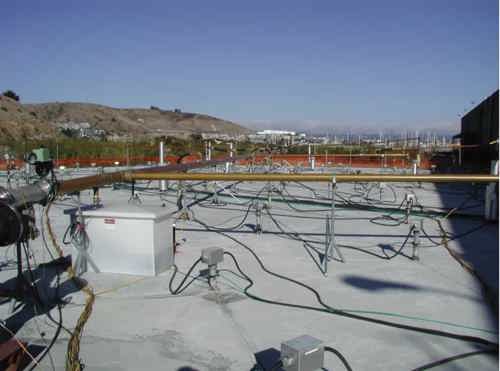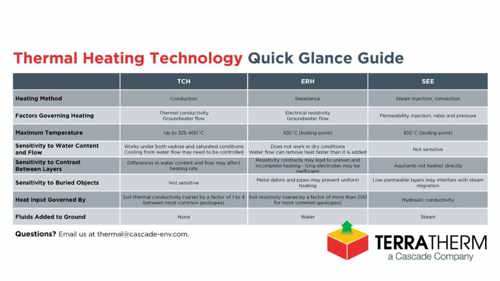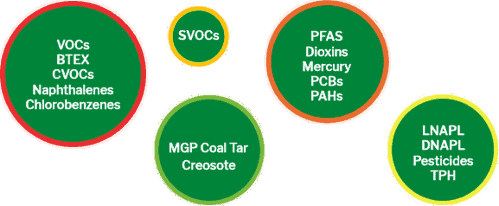Are you in need of a solution for a site with contaminants that are hard to treat, an aggressive schedule, and/or stringent cleanup goals? Then thermal remediation and thermal remediation technologies may be worth considering.
Thermal remediation is one of the most robust methods for treating contaminated source zones. It provides a fast and highly effective means of eliminating constituents of concern from soil and groundwater, and has been used successfully for more than two decades. But even consultants who are familiar with the primary thermal remediation technologies are not always certain if a site will be a good candidate for thermal, or what the appropriate thermal technology selection should be.

Why is site characterization important?
So, how do you determine if a site is a good fit for thermal? And what information do you need to make that call?
First and most importantly, you need a good understanding of the current site conditions. Thermal remediation consists of the application of energy, in various forms, to heat a contaminated source zone and drive off (e.g., volatilization) or degrade subsurface constituents. Thermal is most cost-effectively used to target areas of a site with the highest contaminant concentrations or DNAPL/LNAPL.
This is why it is important to complete a proper site characterization in advance to determine the extent of the contamination that should be targeted with thermal. Thorough site characterization data includes contaminant concentrations, boring logs, soil porosity, conductivity and saturation, water table data, elevations, and subsurface utilities and infrastructure.
Sites that are not well characterized prior to thermal often face increased cost and extended timelines. Typical schedule impacts include inaccurate mass estimates, heating and extraction challenges resulting from unknown site geologies or hydrogeologies, and difficulties meeting remedial objectives because of high contaminant concentrations (e.g., DNAPL) outside of the designated treatment zone.
Site characterization data is the foundation for solid thermal remediation design and implementation. With the right data, we can determine if the site will be a good fit for thermal and select the appropriate technology and design.
How do you choose the right thermal technology?
Once you know that thermal is a good option, how do you select the right technology? Technology selection is highly dependent upon two factors: 1) the contaminants to be treated and 2) the site geology and hydrogeology.

Thermal conduction heating (TCH) allows for a wide range of temperature control and flexibility within the treatment zone. TCH heaters can operate anywhere from ambient up to approximately 650 to 800°C (1,200 to 1,500°F), giving the flexibility to run at a lower temperature to enhance bio degradation or abiotic processes, or heat the treatment zone to temperatures well above the boiling point of water to remove hard-to-treat contaminants (e.g., 350°C [660°F]).
TCH is most commonly applied in situ, but can also be applied ex situ as demonstrated by our In Pile Thermal Desorption® (IPTD®) technology. IPTD® is often utilized in scenarios where the contaminated soils are spread over a large, shallow, surface area, where it becomes more cost effective to excavate and treat the soils in an above ground structure.
TCH wells can be installed at an angle to target areas with access challenges, such as sloped areas, occupied buildings, or roads. This technology is suited for a wide range of geologies like clays, tills, silts, silty sands, sands, and both fractured and competent bedrock (i.e., sedimentary, metamorphic, and igneous); however, if the geology is permeable and saturated, then there may be excess groundwater flux which could adversely impact heating.
Electrical resistance heating (ERH) allows for similar flexibility and control of temperature as TCH; however, ERH requires water to be present to effectively conduct electricity in the subsurface. This limits ERH to treating to a maximum temperature of approximately 100°C (212°F). Fortunately, this treatment temperature is applicable for the large majority of thermal projects.
ERH can also be impacted by high groundwater flux, thus having this information as part of the pre-thermal site characterization can have a big impact on the decision of whether or not to use ERH technology. Soils with very low or very high electrical resistivities may also impair heating; however, sites with the appropriate properties for ERH often heat up quicker and more uniformly than TCH due to the nature of current flow through the soil. The optimal geologies for ERH are typically moderate to low permeable deposits such as clay, silts, silty/clayey sands and high-porosity saturated rock systems.
Steam enhanced extraction (SEE) can heat the subsurface to a maximum temperature around the boiling point of water accounting for hydrostatic pressures (100°C [212°F] at the water table). With steam flushing commonly being the primary contaminant removal mechanism for thermal sites, SEE is a targeted option that offers a direct steam supply to the subsurface and is not reliant on conductive or resistive heating progression to produce steam in situ.
This technology is best suited for sites with permeable geologies, like sands and gravels, that are amenable to steam injection and propagation. Since water is injected as steam, SEE should only be utilized, if the steam condensate can be properly captured, to avoid contaminant spreading. It is often applied to geologies with faster groundwater flow that would otherwise be difficult to treat with TCH and ERH. SEE can also be combined with TCH and ERH to address sites with complex geologies (i.e., both low and high permeability zones).
What chemicals can be treated with thermal remediation?
Thermal remediation technologies can be used to treat a wide variety of chemicals. TerraTherm most commonly treats sites contaminated with volatile organic compounds (VOCs) and semi-volatile organic compounds (SVOCs); however, we have also treated sites contaminated with total petroleum hydrocarbons (TPH), manufactured gas plant (MGP) coal tar, creosote, dioxins, polychlorinated biphenyls (PCBs), polycyclic aromatic hydrocarbons (PAHs), mercury, etc. Because of the robust nature of thermal technologies, we have the ability to target a large range of contaminants with different boiling points, molecular weights, densities, and solubilities.

Contaminants with high boiling points, such as per- and polyfluoroalkyl substances (PFAs), dioxins, PCBs, and PAHs, require the use of TCH, so that the treatment zone can achieve high enough temperatures to volatilize the contaminants. Most other contaminants can be effectively treated using any of the three primary technologies.
Thermal remediation projects typically operate for six months to one year, which is orders of magnitude faster than some of the other more common methods for site cleanup. Thermal remediation is a safe and effective option for sites with high contaminant loading, and for stakeholders that are trying to achieve stringent cleanup goals quickly, efficiently, and reliably.
Contact me if you have a site you would like to discuss.
05.27.21
Nikole Huard
Nikole Huard is a Chemical Engineer and is one of the lead Project Engineers at TerraTherm. During the 7 years she has worked at TerraTherm, she has been designing thermal systems, managing operational data from the field, writing technical work plans and repo...


